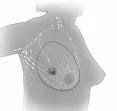If the cancer cells involve more than a quarter of the breast, conservation of the breast will become not feasible. Thus, the patient needs to have a mastectomy, which is the surgical removal of all the visible part of the breast. The entire breast, nipple and areola (the dark circle of skin around the nipple) are removed. The combination of general anaesthesia, epidural block and intravenous sedation are required.
There are all together five types of mastectomy:
· Modified radical mastectomy - Click Here for Description
· Total or simple mastectomy - Click Here for Description
· Skin-sparing mastectomy - Click Here for Description
· Prophylactic mastectomy - Click Here for Description
· Subcutaneous mastectomy - Click Here for Description

1.) Modified Radical Mastectomy
Women who have invasive breast cancer that has been spreaded to the lymph nodes and women with invasive breast cancer who are not candidates for sentinel node biopsy usually have this operation
Radical is used in this surgery and it refers to a few different surgical procedures. It depends on what is done to the pectoral muscles ( the muscles attached to the front of the chest wall and upper arms).These muscles usually can remain intact, but there are occasions when the smaller and deeper minor pectoralis muscle is cut out either partially or entirely depending on the spread of the cancer.
In modified radical mastectomy, lymph nodes are removed and all breast tissues are removed in one piece. Besides, skin and nipple are removed as well. After all the breast tissue is removed, the surgeon will insert drains under the skin lap and the wound is sewn up.
2.)Total or simple mastectomy

Women who have in situ cancer ( stage 0) or invasive cancer with negative sentinel node biopsy usually have this operation. This procedure is similar to modified radical mastectomy. The only difference is the pectoral muscles and axillary nodes are kept intact. Removing the lymph nodes can cause lymphedema which is a swelling of the arm that can become a permanent and uncomfortable condition.
3.)Skin-sparing mastectomy
If one is having reconstructive surgery, the excess skin of the breast is preserved instead of removing the skin. The covering of the pectoral muscles can also be safely preserved if it makes the reconstruction easier. Skin-sparing mastectomy can be done with a modified radical mastectomy or a simple mastectomy.
Women with DCIS, Stage I,II or IIIA of breast cancer and women who are having a prophylactic mastectomy are eligible for this process.
Skin-sparing mastectomy allows the surgeon to use less skin from abdomen or back, making the reshaped breast looks more alike to the original breast. Hence, it is helpful when a muscle flap ( flat piece of muscle) reconstruction is chosen.
It requires more technical expertise but it can be done more frequently.
4.)Prophylactic mastectomy
Women who are at high risk for breast cancer are likely to have mastectomy in order to reduce the risk of getting breast cancer.
The risk for getting breast cancer depends on the following factors:
a.) sex
b.) Getting older
c.)Medical History
d.) Family History
e.)Hormone replacement medication
f.) Obesity after menopause
g.) Alcohol intake
·
5. Subcutaneous Mastectomy
The surgeon removes breast gland tissue but leaves the skin, nipple and areola intact to provide better cosmetic result. It is rarely performed as sparing the nipple and areola will cause the patient to feel numb in that particular areas.
After mastectomy...
After a mastectomy, some patients can not move their shoulder much for several weeks. Scar tissue at the site of operation and lymph nodes’ area that have been removed may affect the movement. Rehabilitation involves stretching exercises that help women to regain full range of motion. Besides, direct massage of scar tissue by a physical therapist is recommended.